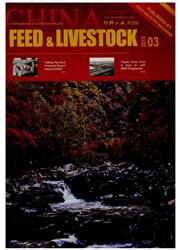

 中文摘要:
中文摘要:
为探索哺乳藏仔猪发育期血液指标动态变化规律及进一步对藏猪进行科学评价与开发利用,分别测定了1、7、14、21、28日龄哺乳藏仔猪的血液生化指标,并与同期(杜×长×大)三元杂交仔猪进行比较。结果表明,藏仔猪各项指标值均在小型猪的正常值范围内,其中ALP和AMM峰值均出现在7日龄,随后逐渐下降;BUN变化趋势与AMM相似,但峰值推迟到14日龄;GPT和GOT含量保持稳定;CRE含量呈极显著连续上升趋势;GLU含量在出生时最低,7日龄后保持稳定;LAC最高、最低值分别出现在7、14日龄;TG呈连续下降趋势,CHO和LDL的变化趋势相似。藏仔猪发育期AIJP、AMM、GPT和GOT含量均高于三元杂交仔猪,与其饲料利用率低,蛋白维持需要量大、肉品质好等特点相吻合;而其脂类相关指标值与人类相近,可能更适合作为人类器官移植的供体、制作心血管方面的疾病动物模型。
 英文摘要:
英文摘要:
In order to further study the serum physiological characteristics of Tibetan pigs during lactation stage and the scientific evaluation and exploitation on it,the experiment was conducted to analyze and compare the blood biochemical indicators in breast-feeding Tibetan piglets and ( Duroc × Landrace × Yordshire) crossbreed piglets with 1,7,14,21 and 28 days,respectively. The results showed that the serum indicators of breast-feeding Tibetan piglets were at range of normal values for minitype pig,and the alkaline phosphatase (ALP) and ammonemic (AMM) in serum peaked at 7 days and followed by a gradual declining trend to the minimum on 28d. It was found that serum urea nitrogen (BUN) showed a similar changing trend to AMM, but its peak delayed to 14d ,while glutamic-pyruvic transaminase (GPT) and glutamic-oxal (o) acetic transaminase (GOT) fluctuated slightly and the carnine (CRE) level had significant increase during the whole stage. The GLU concentration in serum was found to be the lowest at birth and remained stable after 7 days. The maximum and minimum values of LAC ap- peared on the 7th d and 14th d, respectively,Triglyceride in serum undergone a continuous downward trend, and there was strung correlation between cholesterol and LDL concentrations. Furthermore, the activities of ALP, AMM, GPT and GOT in serum of Tibetan piglets were higher than that of (Duroc x Landrace x Yordshire) crossbreed piglets during different stages,which was in accordance with its characteristics of lower utilization rate of feed ,higher maintenance requirements and better meat quality ,etc. The lipid-related indicators of Tibetan piglets were mere similar to human ,which may be more suitably used as human organ transplant donors and animal models for cardiovascular research.
 同期刊论文项目
同期刊论文项目
 同项目期刊论文
同项目期刊论文
 Dietary supplementation with Chinese herbal ultra-fine 3 powder enhances cellular and humorl immunit
Dietary supplementation with Chinese herbal ultra-fine 3 powder enhances cellular and humorl immunit Comparison of the regression analysis technique and the substitution method for the determination of
Comparison of the regression analysis technique and the substitution method for the determination of Dietary supplementation with polysaccharides from Semen cassiae enhances immunoglobulin production a
Dietary supplementation with polysaccharides from Semen cassiae enhances immunoglobulin production a Chinese herbal ingredients are effective immune stimulators for chickens infected with the Newcastle
Chinese herbal ingredients are effective immune stimulators for chickens infected with the Newcastle Dietary supplementation with acanthopanax senticosus extract modulates gut microflora in weaned pigl
Dietary supplementation with acanthopanax senticosus extract modulates gut microflora in weaned pigl Dietary L-arginine supplementation increases muscle gain and reduces body fat mass in growing-finish
Dietary L-arginine supplementation increases muscle gain and reduces body fat mass in growing-finish Intramuscular administration of zinc metallothionein to preslaughter stressed pigs improves anti-oxi
Intramuscular administration of zinc metallothionein to preslaughter stressed pigs improves anti-oxi Effects of Chinese herbal ultra-fine powder as a dietary additive on growth performance, serum metab
Effects of Chinese herbal ultra-fine powder as a dietary additive on growth performance, serum metab Effect of galacto-mannan-oligosaccharides or chitosan supplementation on cytoimmunity and humoral im
Effect of galacto-mannan-oligosaccharides or chitosan supplementation on cytoimmunity and humoral im Effect of replacement of lactose with partially hydrolysed rice syrup on small intestine development
Effect of replacement of lactose with partially hydrolysed rice syrup on small intestine development Rice protein concentrate partially replaces dried whey in the diet for early-weaned piglets and impr
Rice protein concentrate partially replaces dried whey in the diet for early-weaned piglets and impr Dietary Arginine Supplementation Increases mTOR Signaling Activity in Skeletal Muscle of Neonatal Pi
Dietary Arginine Supplementation Increases mTOR Signaling Activity in Skeletal Muscle of Neonatal Pi .High-level expression, purification and antibacterial activity of bovine lactoferricin and lactofer
.High-level expression, purification and antibacterial activity of bovine lactoferricin and lactofer Dietary amylose and amylopectin ratio and resistant starch content affects plasma glucose, lactic ac
Dietary amylose and amylopectin ratio and resistant starch content affects plasma glucose, lactic ac Manipulation of dietary nitrogen, amino acids and phosphorus to reduce environmental impact of swine
Manipulation of dietary nitrogen, amino acids and phosphorus to reduce environmental impact of swine Dietary supplementation with l-arginine or N-carbamylglutamate enhances intestinal growth and heat s
Dietary supplementation with l-arginine or N-carbamylglutamate enhances intestinal growth and heat s Intestinal and renal Type II NaPi co-transporter gene expression patterns in growing pigs fed with d
Intestinal and renal Type II NaPi co-transporter gene expression patterns in growing pigs fed with d Effects of digestible lysine levels on growth performance, serum metabolites and carcass composition
Effects of digestible lysine levels on growth performance, serum metabolites and carcass composition Effects of dietary supplementation with an expressed fusion peptide bovine lactoferricin–lactoferram
Effects of dietary supplementation with an expressed fusion peptide bovine lactoferricin–lactoferram Impaired translation initiation activation and reduced protein synthesis in weaned piglets fed a low
Impaired translation initiation activation and reduced protein synthesis in weaned piglets fed a low Dietary supplementation with Astragalus polysaccharide enhances ileal digestibilities and serum conc
Dietary supplementation with Astragalus polysaccharide enhances ileal digestibilities and serum conc Dietary supplementation with Acanthopanax senticosus extract enhances gut health in weanling piglets
Dietary supplementation with Acanthopanax senticosus extract enhances gut health in weanling piglets Molecular cloning, distribution and ontogenetic expression of the oligopeptide transporter PepT1 mRN
Molecular cloning, distribution and ontogenetic expression of the oligopeptide transporter PepT1 mRN Acanthopanax senticosus extract as a dietary additive enhances the apparent ileal digestibility of a
Acanthopanax senticosus extract as a dietary additive enhances the apparent ileal digestibility of a Molecular cloning, tissue distribution and ontogenetic expression of the amino acid transporter b0,+
Molecular cloning, tissue distribution and ontogenetic expression of the amino acid transporter b0,+ The effect of dietary addition of a polysaccharide from atractylodes macrophala koidz on growth perf
The effect of dietary addition of a polysaccharide from atractylodes macrophala koidz on growth perf 期刊信息
期刊信息
